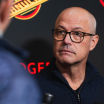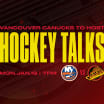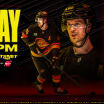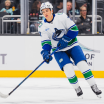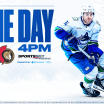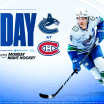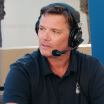"Oh my goodness, is that who I think it is?"
It's the summer of 2017. I'm working my first job as a busboy at a local winery restaurant in my hometown of Kelowna, British Columbia. Out of the corner of my eye, I catch a glimpse of someone unmistakable. NHL veteran Scott Hartnell and his signature curly locks stroll through the entrance to the bistro.
Botchford Project - Kelowna's NHL Bubble
…Why My Hometown Attracts NHL Players
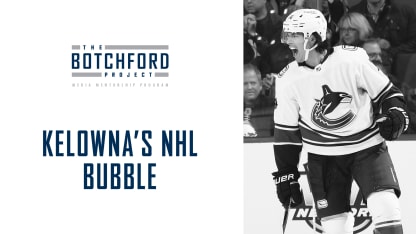
By
Max Purdon @Purd0me / Vancouver Canucks
"And he's with the Schenn brothers! And Tyson Barrie!" I excitedly remark to a nearby coworker.
It's a classic Kelowna summer night. The four NHLers and their partners take in the view from their patio table. There's not a cloud in the sky and the sun is slowly creeping down toward the mountains that outline the west side of the Okanagan Valley. The weather is warm and the restaurant's patrons can lounge and eat in comfort outdoors. The light from above reflects upon the surface of the valley's crown jewel: Okanagan Lake.
I spent the night in awe at their mere presence. It was the first time I'd ever encountered the phenomenon that I had heard about so often throughout my childhood: that NHL players flocked to Kelowna during their offseasons.
It's true. Pro hockey players inhabit the interior like giants walking amongst men - both figuratively and literally. Enormous posters of Canucks 6'8" defenceman Tyler Myers drape the walls of my local gym facility with testimonials from the man himself about the quality of his Kelowna-based trainers. If you spend enough time around the facility, you'll surely end up seeing Myers' towering frame in person when he trains and skates on the ice next door.
Any summertime resident of Kelowna is granted a unique proximity to NHL players in their off months. I've had a multitude of encounters with world-class athletes that are typically restricted to the digital confines of my TV screen. To have been able to rub shoulders with players throughout the back end of my adolescence sparked the flames of my passion for hockey and sports.
Myers isn't the only Canucks player to have settled in the valley. Forward Curtis Lazar calls Kelowna home in the summer, as does defenceman Luke Schenn. When the Canucks acquired blueliner Ethan Bear and winger Lane Pederson from the Carolina Hurricanes early this season, they joined that group.
Why does this happen? Kelowna is isolated from Canada's premier urban locales by vast mountain ranges to the east and west. It's disconnected from the country's ocean-to-ocean roadway, Highway 1. Why does it attract so many professional hockey players? How do they even find out about it?
For Ethan Bear, his first impression of Kelowna came in 2011 when he joined the Kelowna-based hockey academy Pursuit of Excellence as a 14-year-old. Since renamed RINK academy, NHL legend and fellow Kelowna inhabitant Jarome Iginla now coaches the U15 Prep team that Bear once played on.
"I loved the city and I loved the area," Bear said about his first impressions of Kelowna as a teenager. "[I noticed] how beautiful it is with the mountains, the way the city is, [and] the lake."
During his four-year junior hockey stint as a Seattle Thunderbird, Bear met his future fiancée, a native of West Kelowna. "That gave me another reason to go back [to Kelowna]," Bear explained. "I visited her all the time and trained there when I got the chance. When I could make it official, I moved back."
Bear isn't the only Canuck that had their first taste of Kelowna life playing there in their youth. Tyler Myers and Luke Schenn both played for the WHL's Kelowna Rockets, one of the most successful organizations in all of Canadian junior hockey. Curtis Lazar also played for the Pursuit of Excellence U15 Prep team just a couple of years before Bear arrived.
Bear's Instagram page features a couple of photos of him with a bevy of NHL players in Kelowna. His posts showcase how the town has become a gathering place for NHLers from across the league between seasons, Bear's junior teammate and Islanders star forward Mathew Barzal alongside the Canucks defenceman with Okanagan Lake behind them.
As a Kelowna native, it's easy to see why. The natural beauty of the area is obvious from almost every vantage point. The weather is miraculously warm and dry in the summer, something that was attractive to Bear as soon as he first came into town.
"The weather is great," he affirmed, "it's hot and the winter's not too cold." The lake itself also serves as more than just a picturesque backdrop. It provides recreational opportunities for paddleboarding, kayaking, and wake surfing; all low-impact, low-risk activities that aren't prohibited in the fine print of NHL contracts.
When asked if a fraternity of sorts forms amongst players who summer in Kelowna, Bear confidently said it does. After he was jarringly traded across the continent midseason, the landing was softened for Bear when he entered the locker room and saw the familiar faces of his K-Town companions. "That's the cool thing," he told me, "you make friends over the course of the summer. When it works out that you're on the same team it just makes it that much better."
The allure of Kelowna, however, doesn't just lie in the natural quality of the city and the area. "It's really cool. Kelowna is a smaller town," Bear explained. For many NHLers, the bustling and densely populated markets of the league are a departure from what they grew up in. Bear was raised in the Ochapowace Nation outside of Whitewood, Saskatchewan, a tiny town well east of Regina. Curtis Lazar grew up in Vernon, an hour or so north of Kelowna with a population of around 40,000. Luke Schenn was raised in Saskatoon, a town whose population is far closer to that of Kelowna than that of Vancouver. For many, getting away from the big city lifestyle in Kelowna seems to be a breath of fresh air, without sacrificing offseason competition.
Having a relatively small population and being home to so many NHLers, the city surely has a booming NHLer per capita rate, and Bear hopes even more pros come in the future. "Hockey-wise, it's just better that more players are coming. When we do skate in the summer it's more competitive and guys push each other," he acknowledged.
That competition is visible when you get an occasional glimpse of their skates on public ice. They play with real effort, battling in corners and firing pucks hard. They're staying in game shape and getting the opportunity to compete against the best of the best, even when they're in their off-season oasis.
Whenever I see this happen on the very ice surfaces that I grew up practicing and playing on, I'm always taken back to that summer night in the restaurant; the first-ever intersection of worlds between my home and my passion. As I've grown older, the bond between those two has only grown stronger.
Inevitably, more and more players will migrate to Kelowna for the same reasons as the ones that preceded them.
Just as inevitable are the kids who will feel how I felt standing in that restaurant: awe-struck, and forever inspired.

